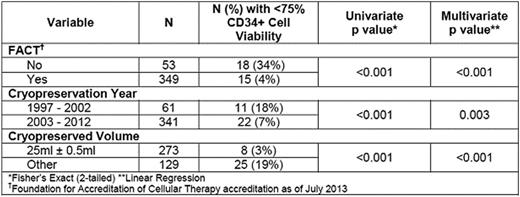Abstract
The selection of CB units with a high engraftment potential is key to the success of single and double-unit CB transplantation (CBT). However, the best predictors of engraftment potential at the time of unit selection and prior to infusion are not established.
We analyzed determinants of engraftment in recipients of double-unit CBT at our transplant center (TC) who underwent myeloablative conditioning for hematological malignancies from 10/2005-5/2013. As infused viable CD34+ cell dose was critical to engraftment in this analysis, we then evaluated units thawed at our center for the two determinants of infused viable CD34+ cell dose: post-thaw CD34+ cell recovery and CD34+ cell viability. CD34+ cell recovery was calculated as TC CD34+ cell count/Bank CD34+ cell count. Post-thaw viability was evaluated by flow cytometry using modified ISHAGE gating and 7-AAD exclusion to assess the percentage of viable CD34+ cells (of total present).
The cumulative incidence of neutrophil engraftment in the 128 myeloablative double-unit CBT recipients was 96% (95%CI: 93-100%). Reported Bank total nucleated cell (TNC) dose, Bank CD34+ cell dose, TC infused TNC dose, TC infused total CD34+ cell dose, TC infused viable CD34+ cell dose, and TC CFU dose were all significantly associated with neutrophil engraftment on univariate analysis. However, only the infused viable CD34+ cell dose was significant on multivariate analysis [HR=1.95 (1.33-2.86), p = 0.001, Figure]. Platelet engraftment was also strongly associated with infused viable CD34 cell dose (data not shown). To evaluate the reliability of CD34+ cell counts and determinants of viability, 402 units (302 domestic and 100 international) from 43 Banks thawed at our TC between 10/2005-5/2013 were then analyzed. For 7 selected Banks accounting for 135 (33%) units, there was strong correlation between Bank and TC CD34+ cell counts (r2 = 0.8, p < 0.001) with a median 92% CD34+ cell recovery at the TC (range 44-189%). However, for the remainder, there was greater variation in CD34+ cell recovery (range 12-1480%, median 107%) with a weaker (but still significant) correlation between CD34+ cell counts (r2 = 0.5, p < 0.001). In 40 (10%) units the recovery was less than 66%. Finally, while the median post-thaw CD34+ cell viability was 92%, it ranged 34-99%, and 33 units (8%) had <75% viable CD34+ cells. Unit characteristics significantly associated with CD34+ cell viability are shown in the Table. Bank location (domestic vs. international), shipping distance (New York vs. Australia), processing method (manual vs. automated or semi-automated) and unit hematocrit did not correlate with viability. In multivariate analysis, Bank FACT accreditation, year of cryopreservation, and cryovolume were associated with viability.
Infused viable CD34+ cell dose was the critical determinant of neutrophil and platelet engraftment. Although correlation between Bank and TC CD34+ cell counts was excellent for some banks and post-thaw CD34+ cell viability was satisfactory for the majority of units, 17% of units had <66% CD34+ cell recovery and/or <75% CD34+ cell viability post-thaw. The variability in CD34+ cell recovery and viability was not random but linked to known differences in banking practice and at least one independent measure of Bank quality (FACT accreditation). These findings have significant implications to CB banking and transplantation. Although units can be selected based on CD34+ cell dose, TC must be able to react to lower than expected post-thaw CD34+ cell counts and/or low CD34+ cell viability. Thus, methods to measure the infused viable CD34+ cell dose on transplant day (or other rapidly available measures of potency) should be employed to ensure the delivery of a graft with optimal engraftment potential and a back-up strategy in case of a compromised unit. This is even more important in single-unit CBT in which, unlike double-unit CBT, engraftment is solely dependent on a single unit.

No relevant conflicts of interest to declare.
Author notes
Asterisk with author names denotes non-ASH members.


This feature is available to Subscribers Only
Sign In or Create an Account Close Modal